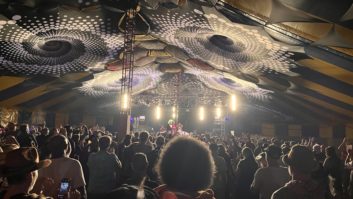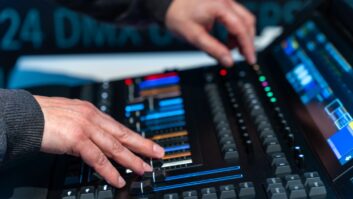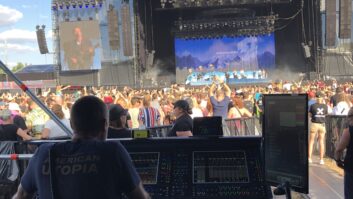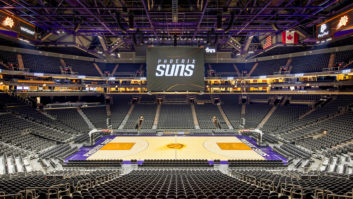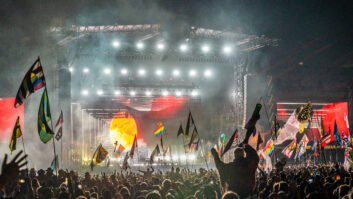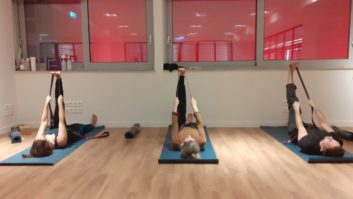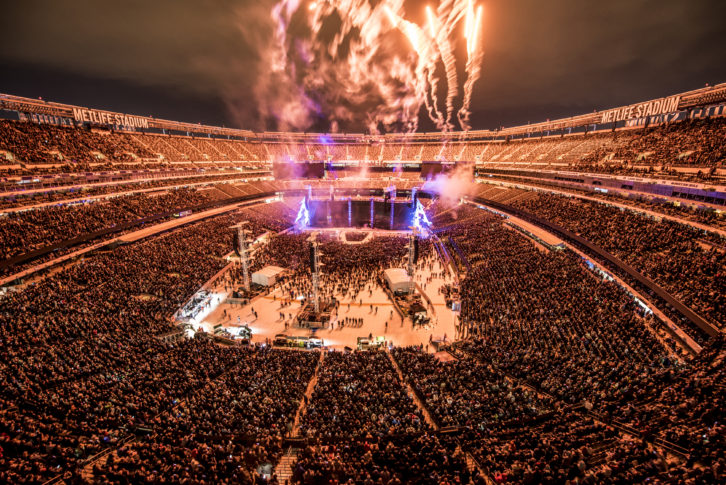
Noise regulations and increasingly elaborate staging have generated a fresh wave of challenges for audio crews working on outdoor events. But, as David Davies discovers, a great result can often be achieved by careful planning and the use of directive audio systems.
Professional audio has been more prominent than usual in the mainstream media over the last few months, and not always for the most positive reasons. A spate of stories have highlighted sound issues – or, in some cases, ‘lack of sound’ issues – at major outdoor shows held as spring turned into summer.
Specific examples included the first UK show by The Strokes for four years at the All Points East festival in London. It was widely reported that the crowd depleted as the set progressed due to insufficient sound levels. According to the BBC News website there were reports of audience members chanting “turn it up”, while one attendee memorably tweeted that “if you want to replicate the experience of going to @allpointseastuk put your laptop volume on 50% and stand two rooms away”.
But perhaps the most high-profile recent instance surrounded the Spice Girls’ much-publicised comeback tour. Muffled vocals and partially audible between-song chatter were cited by those who took to social media to air their frustrations after the first show in Dublin – and there were similar remarks made after some subsequent shows.
Although the precise cause of the difficulties in both of these cases remains a matter of debate, there are undoubtedly several key factors that can undermine the sound quality of large-scale outdoor shows. In this article we will examine some of these issues, as well as look at the ways in which the latest generation of directive audio systems and related software packages are helping to improve the quality of outdoor event sound.
Production pitfalls
Having written about professional audio for nearly two decades, I have lost track of the number of times an engineer or touring company has drawn attention to the money and attention lavished on video and lighting – to the detriment, it may be felt, of the audio. But in this current era of hugely elaborate arena and stadium productions, it appears that this argument may have acquired new weight.
At the most basic level, the preponderance of elaborate stage features, including walkways and auxiliary stage areas, means that it may be impossible to position loudspeakers where they would be ideally located for the best results. As veteran sound engineer Robb Allan told BBC News recently, “even though we design speaker systems by computer, if we can’t put our speakers in the right place because of video screens, or because of walkways or the stage, it makes it harder”.
The issue of staging is a complex one. During a period when people are often found to be staring obsessively into their devices, and have access to more home-based distractions than ever before, it’s understandable that a sizeable school of thought says that spectacular productions represent the best chance of separating gig-goers from their hard-earned pay. And this applies as equally to pop performers as it does to rock-oriented acts, with Muse and Rammstein among those making headlines at the time of writing for their latest son et lumière extravaganzas.
But aside from the challenges elaborate staging can create for loudspeaker placement, there are some who feel that an over-emphasis on the visual can lead to the audio budget suffering. As Bob McCarthy, director of system optimisation at Meyer Sound, remarks: “Spending 90% of the production budget on video is as likely to degrade sound quality as noise regulations.”
Leading systems integrator and founder of RH Consulting, Roland Hemming, agrees that insufficient budget is a recurring contributor to poor-quality outdoor shows. “Engineers can find themselves pushed into a situation where they do not have all the equipment they need for a high-quality arena or stadium concert,” he says. “This tends to be driven by a desire to save money on the overall costs, but it means the production standards will suffer.”
Noises off
The impact of overarching production design and budgets will inevitably vary from project to project, but there is a general consensus that the greatest challenge to outdoor audio quality comes in the form of noise regulations. For most outdoor events, the granting of licences by local authorities will include an agreement of noise levels and curfew times. The extent to which the local community welcomes regular, or even irregular, live events will inevitably have an impact on the application of these regulations. It also follows that in areas where the community is especially vocal or powerful – the environs of Hyde Park springs to mind – the staging of outdoor events is more likely to be contentious.
Hemming believes that noise issues now constitute “an international problem”, caused at least in part by the fact that “environmental noise restrictions are often handled by people who do not really understand sound. But there are other issues to bear in mind, such as the fact that there are always dynamic changes throughout an event – such as what’s happening on stage or the behaviour of the crowd – that can impact upon sound levels. Then, if a concert is being broadcast, decisions may need to be made about whether the live event itself or the broadcast is the priority. One will necessarily take precedence over the other in terms of the impact on people’s enjoyment.”
Established in 1990, SFL is a leading audio visual production supplier both in the UK and internationally. According to head of audio Harvey Appleton, the noise regulation issue is “becoming more important for event organisers and promoters, and it’s something that we as a sound system supplier are having to address head-on and work with our clients to tackle. Noise regulations at outdoor events – and even events with temporary structures such as big tops and marquees – are subject to more and more noise ‘policing’ from councils. It becomes even more important for organisers when noise regulations and measurements are part of their event license, so having acousticians on hand with calibrated monitoring systems [with logging capabilities] is very helpful.”
The day-to-day impact of noise regulations on outdoor venues is the subject of variation. Some outdoor stadiums may have annual licenses that permit a certain number of events to take place and on certain specific terms, allowing them to plan well in advance. For one-off events like festivals that will inevitably prompt an abrupt spike in visitor levels to a certain area – and all the potential impact that may have on the community – individual licenses will need to be granted, and depending on the politics of the local area these may be perceived as being to the conservative end of the spectrum.
But there is another take on noise regulations, as outlined by McCarthy. “Noise level restrictions can cut both ways,” he says. On the one hand, “they can cause so much level reduction that it creates an unsatisfactory result for the concertgoers and the artist’s engineers. Conversely, a totally unregulated environment can result in terrible sound due to too much level being asked of the loudspeaker systems. [In these scenarios systems can] run into gross overload/compression, resulting in poor transmission quality that is potentially damaging to the listeners.”
McCarthy isn’t alone in voicing sentiments to the effect of, as he puts it, “the blame game for bad sound [being] standard operating procedure any time that bad reviews come out. Blaming noise level regulations is very convenient, but may or may not be accurate in a particular case. [So, for instance] poor system design or a touring system’s lack of adaptability to an unusual venue shape can quickly lead to sound going to the wrong places.”
Nonetheless, he does believe the situation is more problematic in some regions than others. “As it stands now the noise level standards throughout the UK and Europe are decidedly non-standard,” he asserts. “The current Metallica tour in Europe is facing a new standard every show. So far it has been able to maintain a high quality experience within the limits, but the diversity of interpretation definitely leads to daily stress (as if we needed more of that!).”
Whatever the ins and outs of individual cases, it’s evident that recent developments in directive audio systems – as well as the software calculation systems that tend to underpin them – are often helping rental companies to achieve good results even in the more challenging of circumstances. As Appleton remarks: “While noise emission is becoming more of a problem, at the same time technology is getting better and giving us new tools to help tackle the problem.”
A design for live
Once sound suppliers have become fully acquainted with the regulations and expectations affecting a specific event, the onus invariably shifts to system design. Thanks to recent advances in prediction software, it is now – in theory at least – easier than ever to develop a loudspeaker design that delivers audio to where it needs to be, and therefore minimises off-site noise pollution.
For SFL, Appleton remarks: “We do a lot of work before the event in terms of system design. We can now accurately predict not only sound dispersion in a venue, but also far-field transmission from the site as noise pollution using tools such as d&b’s NoizCalc, which uses sound propagation calculations according to international standards (ISO 9613-2 and Nord2000). We can even model what transmission would be like under various weather scenarios such as wind speed, direction and temperature.”
Maintaining an extensive inventory of loudspeaker systems is obviously one method of responding appropriately to any given project. To this end SFL often specifies L-Acoustics or d&b audiotechnik systems for outdoor events, “as we find their tonality, control, rigging and infrastructure work well for us”. A recent investment in d&b’s SL-Series KSL PA system [see Box] has been particularly notable, confirms Appleton.
“The groundbreaking element of the product is broadband directivity, down to 30Hz,” he explains. “This massively helps us to position the PA in a way that all the rejection at the rear-side is towards any problem sites / where most complaints may arise from, yet the audience in front still enjoys the full-range system. We’ve deployed it on several outdoor and indoor events where noise has been an issue, and there have been lots of compliments about how the system has improved historical noise issues.”
Meticulous sound design and successful co-operation between the different departments working on outdoor shows can make a crucial difference, indicates McCarthy. “Spending the money for a sufficient number of properly placed delay towers can help to create satisfactory levels inside the listening area while keeping the leakage into the neighbourhood under control. But these steps cost money, require planning to co-ordinate with other departments, and take time and skill to implement.”
The technology is undoubtedly there for those with the time and resources to spare, though. In particular, says McCarthy, “there have been great advancements in the control of low and mid frequencies with modern directional array techniques. This increased control, as well as advancements in signal processing and analysis, have opened up possibilities for advanced system designs that would have been impossible or impractical before – for example, system designs with higher quantities of delay towers, cardioid delayed subwoofer arrays and even some attempts at active noise cancellation on the perimeter of festivals.”
Audience expectations
As well as practical and technological factors, there is also a commercial context to be borne in mind. Ticket prices for arena and stadium shows have risen significantly in recent years – not exactly helped by the seemingly intractable influence of secondary ticketing operations and automated scalper bots. Add in the fact that “generations of concertgoers are now acclimated to hearing their favourite bands on loudspeakers located a few millimetres away from their eardrums,” and it’s no surprise that, as McCarthy remarks, “audience expectations are higher than ever”.
Despite multiple predictions a few years ago that the long-term growth of the live music market was not sustainable, and that a notable slowdown would inevitably occur, 2019 looks like being another landmark year for the live industry. But as Brexit-related uncertainty continues, and average weekly real-term earnings continue to fall in multiple European countries, concertgoers are bound to think more carefully about which events they truly consider essential – and which can be consigned to the ‘second division’.
In this regard, sound quality – along with general comfort factors and access to basic facilities – is likely to be a crucial determining factor. Another cluster of negative headlines would do no one any favours, so it’s surely in the interests of everyone concerned that all stakeholders work together effectively to deliver events that are as pleasing to the ear as they are to the eye.
